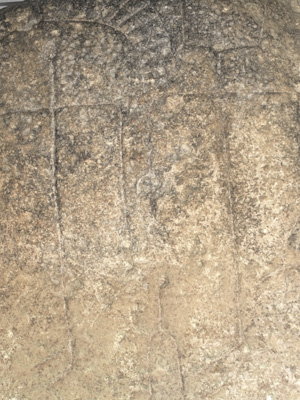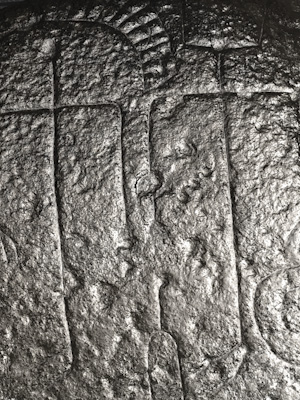Late Bronze Age Stelae, Craftspeople and Digital Technologies: Some Recent Explorations
Reflectance Transformation Imaging (RTI) is revealing itself as a very powerful tool to examine prehistoric rock art. Through the application of different filters and the manipulation of the incidence of light, RTI provides an enhanced visual experience of the micro-topography of engraved stones, enabling the detection of subtle details that are difficult, at times impossible, to be seen through other recording techniques. In our own research, the application of RTI is providing us with valuable information about the craftspeople and the techniques involved in the making of a very special type of prehistoric rock art: Iberian Late Bronze Age stelae (see also previous posts: “RTI shedding new light on Iberian Late Bronze Age stelae” and “RTI & the Late Bronze Age stela of Mirasiviene (Sevilla, Spain)”).


** Detail of the stela of Almadén de la Plata 2 (Almadén de la Plata, Seville). When you click on the image, without RTI enhancement, you will see one of the multiple possible images produced by applying the RTI specular enhancement filter.
Late Bronze Age decorated stelae (c. 1425/1260-800/750 cal BCE) are very abundant in some regions of the Iberian Peninsula. Despite of a long research tradition dedicated to the subject, there are still relevant questions that remain unexplored. One of these is related to the manufacture of these beautiful stones. These stones depict, among others, people, shields, weapons, mirrors and chariots, elements that are usually organized on the surface of the stone following broadly distributed conventions. The engraving of some of these images required skillful hands, for at times the selected stones were specially hard and the tools employed were, most probably, lithic. Iron tools were still not accessible to most Iberian communities at the time, and the available metallic tools, made of bronze or arsenic copper, were too weak for stone working.
Precisely, one of the questions we are trying to elucidate through our research here at Southampton, David Wheatley and I, in collaboration with Leonardo García Sanjuán (University of Seville), is to which extent these engravings were made by itinerant or local craftspeople, and the degree to which rock engraving was a specialized activity. These are, of course, difficult questions and it will be extremely difficult, if not impossible, to provide conclusive answers. Nonetheless, our preliminary research has provided some relevant results that suggest the interesting potential of this line of inquiry if we explore it further.
Our preliminary approach to the subject has included the application of RTI to undertake a comparative analysis of the engraving techniques employed on three Late Bronze Age stelae. Two of these stelae, Setefilla and Mirasiviene (Lora del Río, Seville), were found in nearby locations, only 3 km apart, and display very similar iconographies. The third one, Almadén de la Plata 2 (Almadén de la Plata, Seville), was found 40 km away and displays a distinct, but still formally related, iconography. The three of them may be broadly dated to the same phase, between c. 1200 and 800/750 cal. BCE.


** Detail of the shield of the stela of Mirasiviene (Lora del Río, Seville). When you click on the image, without RTI enhancement, you will see one of the multiple possible images produced by applying the RTI specular enhancement filter.
The preliminary results could not be more interesting, for each of these stelae seem to have been engraved with different ‘packages’ of engraving techniques. If you click on these images, you will see different details that are more clearly seen through RTI filters, in this case the ‘specular enhancement’ filter. The images resulting from the application of varied RTI filters provide ample information to characterize the techniques employed in the engraving of each one of these stelae. You will see, for instance, that whereas the shield of the stela of Mirasiviene has been carefully carved with pecking and abrading, leaving a U shaped section, the shield of Setefilla seems to have been elaborated by less skilled hands, through less defined and more dispersed pecking. Finally, the stela of Almadén 2 provides an alternative to these two previous cases, as the engraving seems to have entailed a combination of pecking, incision and abrading, producing a V-shaped section.


** Detail of the shield of the stela of Setefilla (Lora del Río, Seville). When you click on the image, without RTI enhancement, you will see one of the multiple possible images produced by applying the RTI specular enhancement filter.
As you might have already considered at this point, this initial exploration suggests the possibility that Late Bronze Age stelae were crafted by different engravers with variable and locally rooted knowledge and skills, that is, following local engraving traditions. Now, the question that remains unanswered is the ways through which the iconographic conventions displayed by stelae were ‘disseminated’ and became ‘supra-regional’. Many of the depicted objects (i.e. shields or chariots) are still not known in the archaeological record of the Iberian Peninsula, and when they are represented on stelae, they follow more or less strict representational patterns. In this context, maybe we should consider that certain images, possibly inspiring this kind of representations, could have circulated through the movement of people and things in motion, either as mental templates or as materialized representations on perishable materials. More soon to come….
David Wheatley and I did the RTI of the stela of Mirasiviene during our fieldwork at the site last September. I would like to, very specially, thank James Miles, PhD student at the ACRG and Hembo Pagi for their training in making RTIs and also Víctor Rodríguez Zamora, Master student of the University of Seville, who helped me capturing the images needed to build the RTIs of the stelae of Setefilla and Almadén de la Plata last February. We are also very grateful to Concepción San Martín, director of the Archaeological Museum of Seville, and Pablo Quesada, curator of the museum, for their invaluable support while undertaking our image capturing sessions in the museum.
